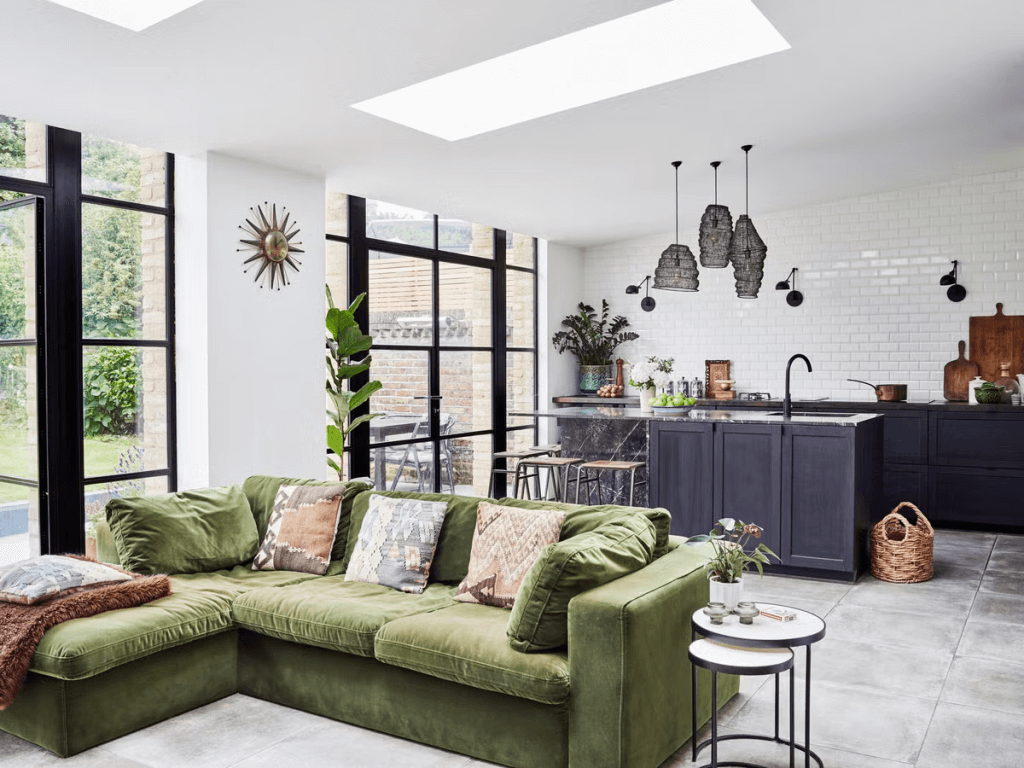As open-concept living becomes more popular in modern home design, many homeowners are faced with the opportunity and the challenge of creating a seamless transition between different functional zones in the home. An important element to achieve this harmony lies in the strategic use of flooring, particularly tiles. By thoughtfully combining living room tiles with bedroom tiles, you can craft a unified look that flows naturally from one space to the next without compromising style or comfort.
In this post, we share some simple and effective ways you can use to create an open space with the right combination of tiles for living room designs and bedrooms.
Reasons Why Tiles Work in Open-Concept Spaces
Tiles have become an increasingly popular choice for both living rooms and bedrooms in open layouts because of their ease of maintenance, durability, and variety of styles. Whatever the tile material you choose – porcelain, ceramic, or natural stone, tiles provide a modern and clean aesthetic, which anchors the entire home design theme.
Living room tiles flooring is a practical choice for homes with kids and pets, where spills, messes, and stains are a regular reality. The trick is in selecting the right type and tone of floor tiles, which work cohesively across living and sleeping areas in the home.
Design Continuity: The Key to Open Space Harmony
Visual continuity is mandatory in open-concept homes. Without doors or walls to separate rooms, flooring is one of the primary elements that unify the whole space. Mentioned below are some effective tips for blending living room designs with tiles for the bedroom:
- Consider the Overall Aesthetics of the Place
The overall theme and design of the home play a major role in choosing tiles for different rooms. If the home’s living room has a modern and chic design and style, sleek and polished tiles with a uniform finish are a great choice. Explore the collection of tiles for the living room, like Marmorica, Venitto, Alchimia, Basaltino, Glyphstone, and many more from premium suppliers like Simpolo Tiles & Bathware.
If you have rustic home settings, you can experiment with stone-look or wood-look tiles to add warmth and texture. For transitional home setups, you can create a balanced look by combining specific elements of both rustic and contemporary home styles for the best results. Make sure that the chosen tiles for the bedroom create a uniform flow to the living space.
- Creating Zoning with Tile Patterns
Open spaces benefit from visual ‘zoning’ to separate areas subtly without erecting walls. Using tile patterns is a stylish and effective solution. For instance, you can try installing tiles in chevron or herringbone patterns in the living room while maintaining a simple grid layout in the bedroom. This not only enhances visual interest but also helps define spaces without hampering cohesion.
- Area Rugs for Warmth and Definition
Tiles are sleek and practical home flooring choices, but they can sometimes feel cold, particularly in a bedroom setting. To add warmth to the place and soften the look, layer area rugs over the tile flooring. For the bedroom, you can choose cosy and plush rugs under the bed. However, for the living room, you can choose larger, statement rugs that sync with the overall seating and décor of the space.
Rugs are smart accessories as they not only enhance comfort but also act as boundary markers in an open floor plan. They subtly create a distinction between rest and relaxation zones in the home.
- Colour Coordination Across Rooms in the House
Whether you are choosing tiles for the living room or the bedroom, consider the overall colour scheme of the house. Warmer hues like taupe, beige, or terracotta offer an earthy and inviting ambience, while cool tones like greys, blues, and whites create a contemporary and tranquil feel. Apart from this, consider the wall colours, furniture, and lighting in the home.
When you choose the tiles for the living room and the bedroom, they should complement all the mentioned elements and not compete with them to gain attention. Choose the tiles in a manner so that they balance the visual weight of the room.
- Tile Texture and Finish Matter
Whether it is bedroom tiles or tiles for the living room, the tile texture and finish matter in ascertaining the visual impact of the space. Finishes of the tiles drastically change the look and feel of the flooring. For instance, matte tiles are an ideal choice for bedrooms. These tiles have less dust accumulation and scratches. They also have a softer and less reflective surface.
In contrast, tiles for the living room are preferably polished or semi-glossy. These tiles reflect more light and can make the space feel large and bright. Combining the finishes between the living room and the bedroom is acceptable in an open-concept layout, as long as the tones and the overall design remain consistent.
Conclusion
Having the right combination of living room tiles with tiles for the bedroom to create an open space requires thoughtful planning. The syncing of the living room design and tiles is mandatory for creating a beautiful and cohesive environment, which is stylish and functional at the same time. By focusing on consistency in colour, tone, and finish and strategically using patterns and accessories, you can achieve a seamless aesthetic that enhances your home’s flow and personality.
Cassia Rowley is the mastermind behind advertising at The Bad Pod. She blends creativity with strategy to make sure ads on our site do more than just show up—they spark interest and make connections. Cassia turns simple ad placements into engaging experiences that mesh seamlessly with our content, truly capturing the attention of our audience.


